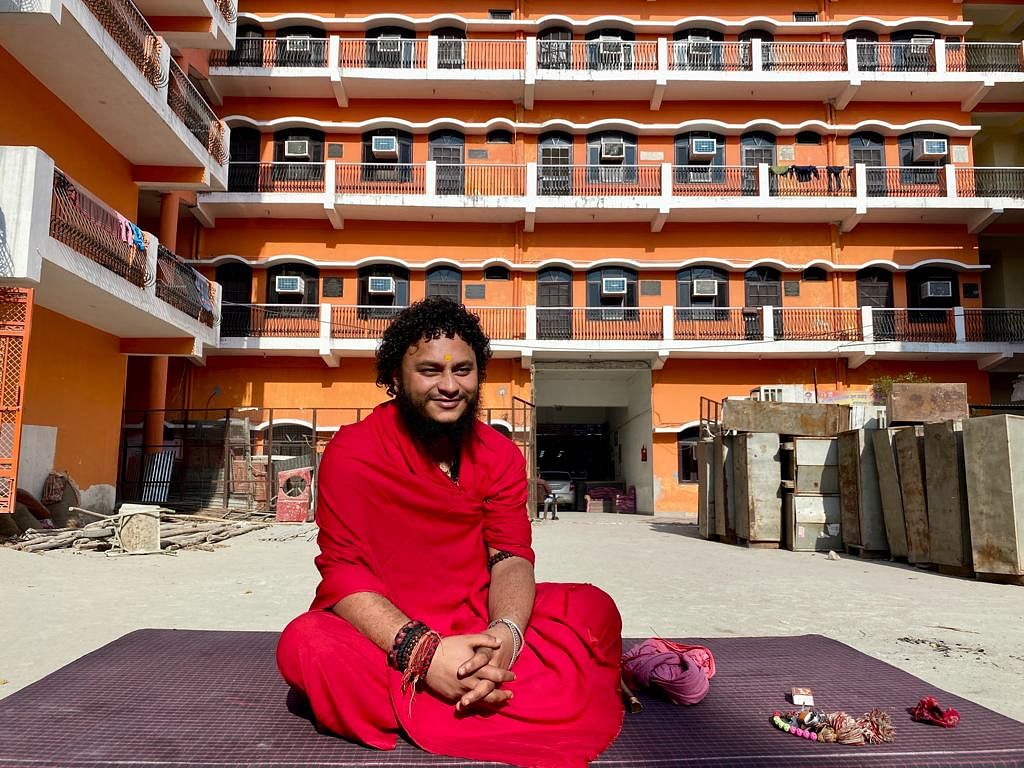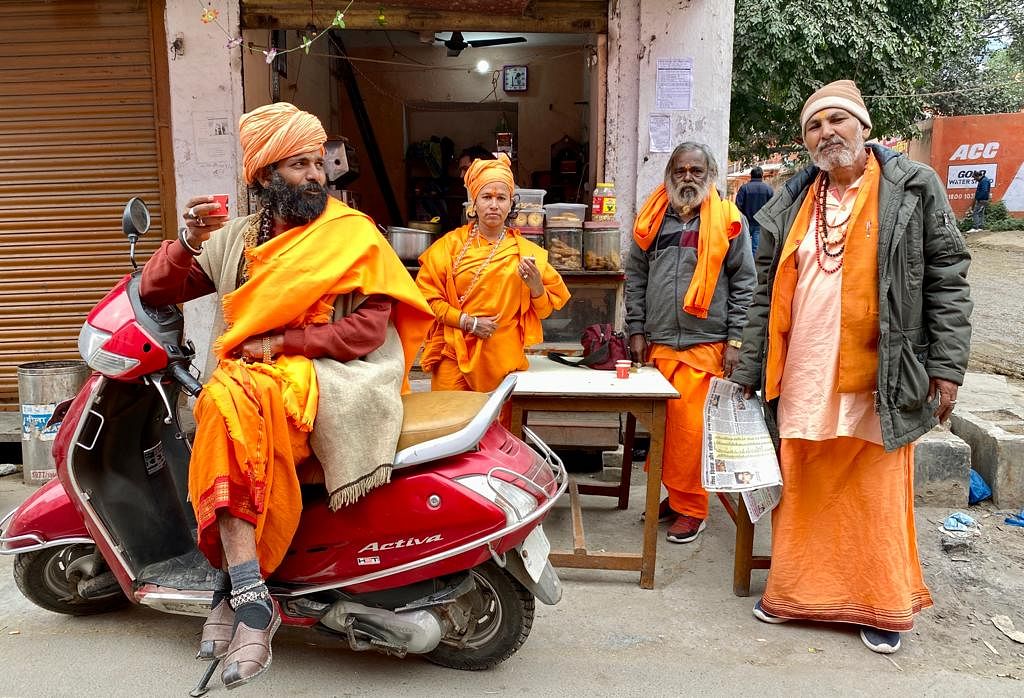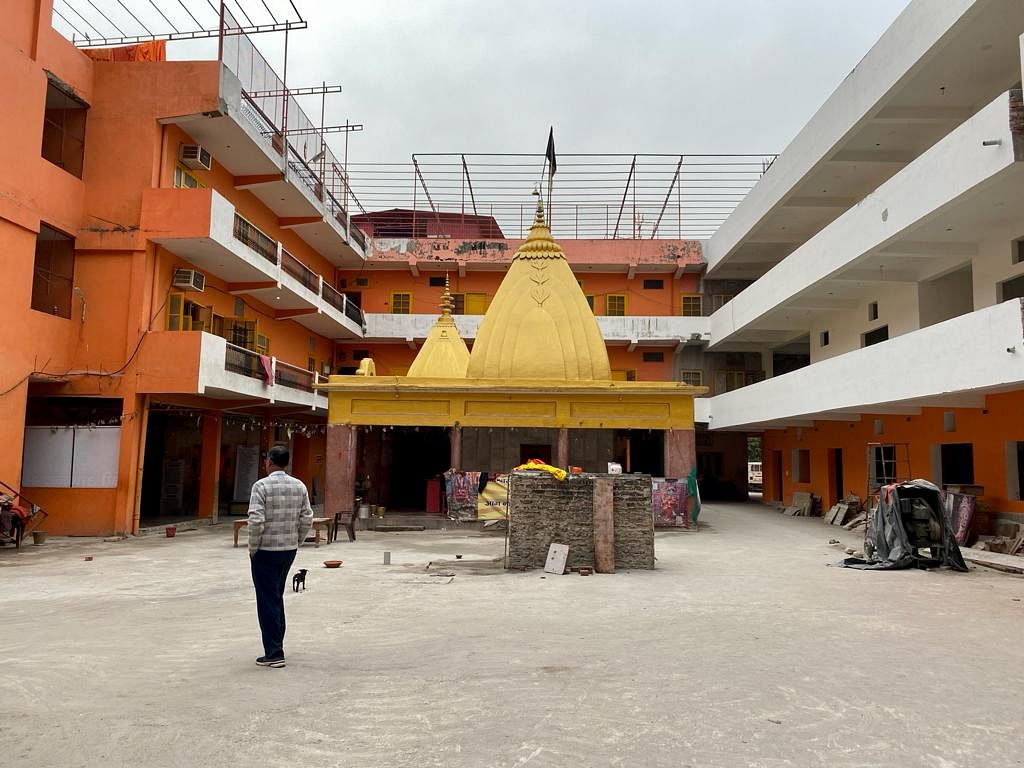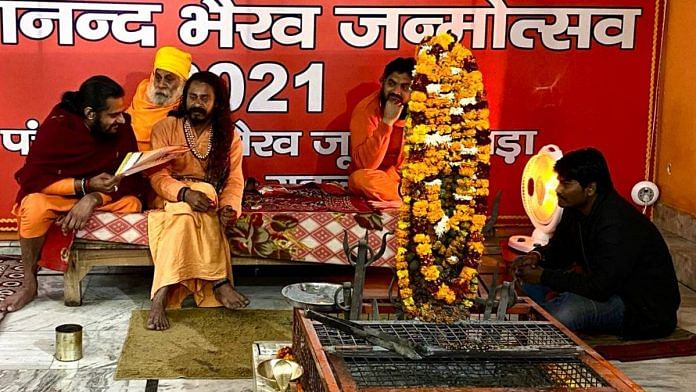Haridwar: A message in Hindi, printed on a large flex poster, dominates the courtyard of the Juna Akhara in Haridwar. It reads: “Do not trust the untrustworthy. Excess addiction generates defects. One should not add fuel to the flames. In short, the angry should not be further angered.”
“To you, this may look like disconnected sentences strung together but it makes perfect sense to me,” 30-year-old Vashisht Giri, one of the mahants (chief priests) at the akhara, tells ThePrint. “It is a secret code. Most things about akharas are secret, limited only to a few chosen sadhus (seers).”
Like the message on the poster, Giri often speaks in a cryptic manner. As he sits on a charpoy in the courtyard of the akhara, soaking up the winter afternoon sun, Giri speaks about “Bhav, Bhavna, Bhagwan (intent, emotion, God)”. He also attends to devotees seeking his blessings, often taking breaks to light one cigarette after another.
Giri owns an iPhone, tracks social media, ends most sentences with expletives, and cracks jokes with other sadhus in the akhara — not traits typically associated with an ascetic. He insists that “unlike most sadhus”, he is a genial person. Only a few things, he says, make his “blood boil”.
One such thing, evidently, is criticism directed at an event in Haridwar held between 17 and 19 December, where Hindutva leaders and seers — some of them from prominent akharas based in the town — called for violence against Muslims.
“If a Muslim speaks against Hindus, it is fine for most people. If a Hindu sanyasi says anything against Muslims, it becomes a controversy. That’s unfair,” says Giri.
Also read: ‘If needed, we can kill them’ — Hindu seers issue call to arms against Muslims at Haridwar meet
Militant wing of monasticism
The controversial ‘Dharam Sansad’ renews focus on the mix of spirituality, power and politics in the akharas — essentially sects of seers originally conceived as the militant wing of Hindu monasticism.
Thirteen prominent akharas are based in Haridwar. They are broadly divided on the basis of their belief systems.
The Sanyas Sampradaya (tradition) has seven akharas — Juna Akhara, Avahan Akhara, Agni Akhara, Niranjani Akhara, Anand Akhara, Nirvani Akhara and Atal Akhara. The Vaishnao Sampradaya has three — Nirmohi Akhara, Digambar Akhara and Mahanirvani Akhara.
There are three akharas that worship Guru Nanak Dev — Bada Udasin Akhara, Naya Udasin Akhara and Nirmal Akhara.
The akharas organise pilgrimages to the 51 Shakti Peethas in the country throughout the year. The biggest events that the akharas take a lead role in organising are the Kumbh Mela, Ardh Kumbh Mela and Magh Mela.
On a daily basis, though, they perform a wide variety of rituals that draw people to the ghats of the Ganga, as well as engage in religious activities and events in the local temples and elsewhere, the sadhus say. They are also involved in the management of dharamshalas, gaushalas, schools, health centres etc.
Akharas support Hindutva
Seers representing prominent akharas have in the past openly supported the Bharatiya Janata Party (BJP) and the Rashtriya Swayamsevak Sangh (RSS).
“If some senior sadhu of an akhara has expressed support for any political party, it can be his personal stand. The akharas officially do not support any political party as such,” says Ravindra Puri, a mahant in Mahanirvani Akhara.
Even if they mostly refrain from associating themselves with political parties, most sadhus are vocal about their commitment towards Hindutva — especially on issues like the Ramjanmabhoomi movement and construction of the temple at Ayodhya. There is a sense of antagonism towards Muslims too.
Giri of Juna Akhara says: “We are never associated with political parties but keep a close watch on who chooses dharma over adharma. We see dharma in construction of a Ram temple…. Muslims have a history of attacking Hindus. What is wrong in showing them that we are capable of fighting them?”

“We support those who are invested in projects concerning Ram Rajya and temples,” says Ravindra Puri (namesake of the above-mentioned), secretary of the Niranjani Akhara and current president of the Akhil Bharatiya Akhara Parishad (ABAP) — an umbrella body of akharas set up in 1954 to organise the Kumbh Mela by enhancing coordination among akharas and settling disputes between them.
Soon after being elected ABAP president, Puri had said in October that the Parishad would “put all its weight behind the BJP” to ensure it wins the upcoming assembly polls in Uttar Pradesh and Uttarakhand.
Speaking to ThePrint, several sadhus highlight another aspect of this commitment towards Hindutva. Several prominent sadhus and mahants currently affiliated to akharas, they explain, were active pracharaks (preachers) in the RSS before they became sanyasis.
“They have held top offices in prominent akharas even though their primary loyalty has always been towards the RSS,” says a senior office-bearer in the Akhil Bharatiya Akhara Parishad, who did not wish to be identified.
“The commitment of sadhus towards Hindutva is not new,” Dhirendra K. Jha, the author of Ascetic Games: Sadhus, Akharas and the Making of the Hindu Vote, tells ThePrint. “The influence of Hindutva, which was consolidated in the 1960s, gained unusual pace during the 1980s and threw the old monastic orders of Hinduism out of gear.”
However, there are points of friction too. Differences between former Uttarakhand Chief Minister Trivendra Singh Rawat, who had to quit his post in 2021, and the akharas over this year’s Kumbh Mela in the light of a Covid-19 surge is learnt to have irked the BJP severely.
Also read: Akhara body caught in successor row after UP mahant’s ‘murder’, 1 group claims leader is elected
Attitudes towards the conclave
The ‘Dharam Sansad’ in Haridwar, which is facing severe criticism for hate speeches has generated a certain frisson in the city — groups of young men participated in random motorbike rallies Sunday, shouting “Jai Sri Ram” in support of the event.
Yati Narsinghhanand Saraswati, the controversial priest facing several FIRs in Uttar Pradesh for hate speech and rioting, was one of the main organisers of the conclave.
“I cannot comment on Yati Narsinghanand or other sanyasis. But I see nothing wrong in what they said at the event,” says Vashisht Giri of Juna Akhara with conviction. “There has to be a balance between anger and calm. We sadhus believe in ‘ek haath me maala toh doosre me bhala (garland in one hand, spear in the other). One cannot be calm all the time. Muslims have historically been aggressive against Hindus. To show them their place, sadhus need to be aggressive.”

Narsinghanand — the mahant of Dasna Devi temple in Ghaziabad — has close links with Juna Akhara, which is believed to be the most influential of all.
In October, Narsinghanand was inducted in Juna Akhara as a ‘mahamandaleshwar’ or ‘high priest’ — a title bestowed by akharas on someone who has achieved the highest levels of Hindu spiritual guardianship. In a practical sense, say several seers, they are the ones expected to generate revenue for the akharas and arrange donations for events such as the Kumbh Mela.
Seers associated with other prominent akharas were among speakers at the event in Haridwar.
One of them was one Annapurna Maa of the Niranjani Akhara, who could be seen in a video from the event saying she would “pick up arms to protect Sanatan Dharma if any demon tries to become a threat to Hindutva”. She was eventually named in the police case registered in connection with the hate speeches in the conclave.
While Giri expresses support for the speeches at the conclave, Puri of Niranjani Akhara deplores it. “I cannot speak for individual sadhus who spoke in the event but as an office-bearer of the akhara we condemn the event,”
Both, however, distance themselves from individual sadhus associated with their respective akharas.
Competing ambitions, differences and resources
“There is immense competition among the akharas and within the akharas,” says Puri of Mahanirvani Akhara, who also condemned the hate speeches.
“Most sadhus in senior posts have individual ambitions. Take the example of Yati Narsinghanand. He has gained immense popularity only through hate speeches. A lot of sadhus now tend to follow the same formula. The akharas cannot accommodate the individual ambition of each sadhu. So, they are most likely to distance themselves from individual names,” he adds.
This internal jostle among seers for gratifying personal ambition is also a reason, say sadhus from prominent akharas, why top office-bearers in akharas are unlikely to back other sadhus from the same set-up openly supporting a political party.
Instances of factional feuds among the akharas over influence and control over resources are also a reflection of individual clout and ambitions of sadhus.
Sadhus invest in building influence. There are those who can always be seen with a few acolytes, often called chelas, around them. Most sadhus in akharas do not shy away from boasting about the number of chelas they have.
Then there are sadhus who move around with ‘escort’ vehicles for greater security.
In the larger political landscape, the akharas are undoubtedly a powerful group. With their massive numbers of followers, they can influence voting patterns, say office-bearers in several akharas.
The entire complex system of the functioning of akharas revolves around huge resources — monetary and otherwise. A primary source is donations.
“If you recall, in 2012, the Juna Akhara appeared on the verge of implosion as one of its sections bestowed the title of mahamandaleshwar on a woman known as Radhe Maa. The primary cause of dispute was money. There were differences among monks that the revenue which came with Radhe Maa was not trickling down in a proportional fashion,” says author Jha.
Donors to akharas cover the entire social spectrum — both spectacularly rich persons and those who are poor. “You will never know who donates to the akharas. We have top politicians and industrialists backing us. Do not get into that zone. We have patrons across the world,” says Giri of Juna Akhara.

These donations have come under the scanner too. On several occasions, the ABAP has appealed to mahants to refrain from accepting black money as donation.
Other assets also play a key role in keeping the akharas well-oiled.
These include land, real-estate, revenue from residential and commercial areas, banquet halls, boarding facilities, educational institutes and parking lots, among others, in prime locations in Haridwar — which hosts large numbers of tourists through the year — and across the country, say several seers.
Currently, akharas do not declare their assets and revenues, several office functionaries in the akharas said. A split among various factions of sadhus has of late led to a clamour among some for a declaration of assets.
Seers say that some assets which belong to the akharas on paper are directly controlled by top sadhus. That practice, too, has been mired in conflict.
Earlier this year, a priest was accused of illegally selling land in Uttar Pradesh, which was either purchased for the akhara or donated by affluent donors.
Dhirendra K. Jha says: “There is clearly the driving force of greed, power and wealth, which throws spiritualism out of the window. Seers undoubtedly derive inspiration from figures such as Yogi Adityanath, who is a monk-turned-chief minister, and then there are many like Yati Narsinghanand, who make careers out of hate speeches. A national commission should ideally be set up to initiate probes on seers who have had criminal records and used their affiliation to akharas only as a means to protect themselves.”
(Edited by Saikat Niyogi)
Also read: Controversial UP priest Yati Narsinghanand is now a top leader of India’s largest akhara






